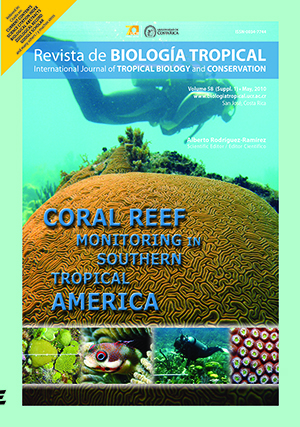Abstract
Long-term monitoring data provide a basis to recognize changes in coral reef communities and to implement appropriate management strategies. Unfortunately, coral reef dynamics have been poorly documented at any temporal scale in the Southern Caribbean. Through the “National Monitoring System of Coral Reefs in Colombia” (Spanish acronym: SIMAC), we assessed 32 permanent plots at different depth levels in six reefs areas of the Colombian Caribbean from 1998 to 2004. Temporal trends in coral and algal cover were evaluated by repeated measures ANOVA. The model included the effect of depth levels (a fixed effect), monitoring plots (a random effect) as a nested factor within depths, and time (repeated factor). We found high spatial variability in major benthic components. Overall means indicated that algae were the most abundant biotic component in nearly all areas, ranging from 30.3% at Rosario to 53.3% at San Andrés. Live coral cover varied considerably from 10.1% at Santa Marta up to 43.5% at Urabá. Coral and algae cover per se are not always accurate reef indicators and therefore they need supplementary information. Temporal analyses suggested relative stability of coral and algal cover along the study but the causes for the observed trends were rarely identified. A significant decrease (p=0.042) in coral cover was only identified for some monitoring plots in Tayrona-time x plot (depth level) interaction, and importantly, few coral species explained this trend. Significant increase (p=0.005) in algal cover was observed over time for most plots in Rosario. Temporal trajectories in algal cover were influenced by depth-significant time x depth interaction-in San Andrés (increase, p=0.004) and Urabá (decrease, p=0.027). Algae trends were mainly explained by changes in algal turfs. Monitoring programs must focus on the mechanisms mediating the changes, in particular those concerning coral recovery and reef resilience in the current context of climate change.Comments

This work is licensed under a Creative Commons Attribution 4.0 International License.
Copyright (c) 2010 Revista de Biología Tropical
Downloads
Download data is not yet available.






